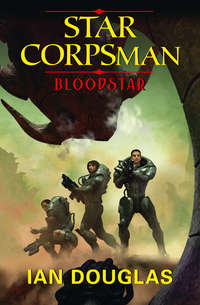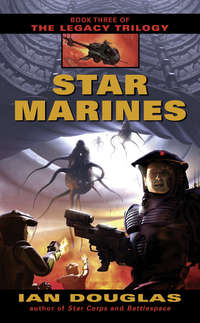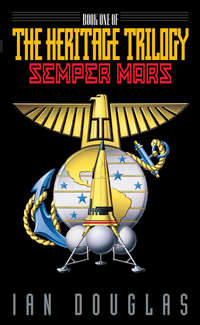
Полная версия
Europa Strike
He was hoping to get off seven times tonight, once with each of them. Theoretically it was possible, but sheer exhaustion had overcome him each time he’d tried it in the past. But tonight he was feeling pretty good, and maybe…
“Leckie!”
The voice boomed from the pink and purple curtains draping the harem chamber’s vaulted ceiling, echoing as though from speakers with the volume cranked up high.
It was a voice he recognized. “Oh, shit….”
“Leckie! This is God speaking! Liberty’s been canceled for all hands.”
“Aw, Sergeant Major! Have a heart, will ya? We just got here!”
“Now, Leckie. Come out of there before I crawl in and pull your plug myself!”
And that conjured visions Lucky didn’t even want to try imagining.
“Hey, Lucky?” Tony called. “Did Sergeant Major Kaminski just—”
“Yes, goddamn it, he did.” He sighed. “Sorry, girls.”
“Aw! You have to leave so soon?”
“Safeword ‘bail-out,’” he said. Instantly, the boudoir, the grapes, the naked women, all faded out into the purple-charged blackness one sees with closed eyes. A moment later, he blinked, and he was staring at the inside of a grungy-looking metal sphere just barely roomy enough to hold a synthleather-padded couch.
A quarter of the sphere’s shell, to his left, was missing, a large, circular hatch. Sergeant Major Frank Kaminski was standing there in his khakis, fists on hips as he glared belligerently into the virtuality capsule. “So sorry to interrupt your pleasant dreams, Mister Leckie,” Kaminski said. “But your presence is required back at the squad bay!”
Lucky sat up and swung his legs out of the sphere. He was wearing nothing but a terry cloth wrap and a number of skin attachments connected to slender feed cables, gently adhering to five places on his scalp, and on his chest, wrists, back of the neck, and groin.
The wrap was to keep him from making a mess on the couch. The cold, sticky spot he felt against his skin on the inside told him it had already served its purpose, even though he hadn’t been inside for very long. “Jeez, Sergeant Major!” he complained, starting to pull off the skin connectors. “It couldn’t have waited another couple of hours?”
“No, it damned well couldn’t!” He turned to glare at the half-naked man crawling out of the virtuality sphere next to Lucky’s. “And you, Tonelli! Get your ass in gear! Both of you!”
Mamasan Koharu, the manager of the Virtuality, all prim and proper in a conservative woman’s business suit, held out a hot, warm towel with a slight bow and a smile. “You have good time, yes?”
“I want a refund, Mamasan! We paid you one hundred dollars each for four hours! That was the deal, see? We ain’t been inside there thirty minutes!”
Her eyes widened. “Oh, no! No refund! Cost same, you thirty minute, you four hour!”
“No! I want my money back!”
“It cost same! Still must program computer!” She pointed at the couch. “Still must clean you cum off equipment! Cost same!”
He snatched the towel from her. “Christ, what a gyp!” He tossed the terrycloth wrap on the floor and began toweling off his legs. “I got rights! You can’t rip us off this way. I’ll get some of my buddies together an’—”
“Corporal Leckie!” Kaminski snapped.
“Yeah?”
“Put a cap on it. Get your clothes on, both of you, and muster with me at the entrance. You’ve got ten minutes. Move it!”
Lucky entertained the notion of arguing for all of perhaps two seconds. It wasn’t right, getting taken for a ride that way! He and Tone had spent twenty minutes in the virtual bar with the tequila and beer, and had only just gotten down to the good stuff deeper in. Damn it! He’d wanted to go with all seven women! Man oh man, what a barracks story that would have made! While his physical body had—um—responded almost at once to the sensations he’d been experiencing inside the sphere, the interactive AI program running through his brain should have easily let him experience seven orgasms in a row in his head.
And now they were dragging him back to base, out a hundred dollars and nothing to show for it but a wet crotch and a semen-soaked wrap!
Yeah…he thought about arguing. But there was something about Sergeant Major Kaminski’s bearing—not to mention the pressed-and-tailored perfection of his khakis and that incredible splash of colored ribbons on his shirt—that made even a veteran griper like Lucky Leckie think twice, then back down. It didn’t help that Kaminski was in full uniform while he was stark naked.
The real problem was that Kaminski was a lifer. Those campaign ribbons—for Mars and Garroway’s March and Cydonia, for Luna, Picard and Tsiolkovsky, for Vera Cruz and Cape Town and Havana, not to mention the Silver Star, the Bronze Star with cluster, the Purple Heart, Expert Rifleman—together they created a truly formidable barrier no mere corporal with nothing but a National Defense Ribbon and an SMEU qualification badge could stand against.
Hell, Kaminski would drop-kick him clear back to V-burg if he even tried.
“Aye, aye, Sergeant Major,” he said. Tossing the wet towel on the floor, he turned and followed Tone into the locker room, where they’d left their clothes. Koharu, who’d modestly turned away at his nudity, was already fastidiously scrubbing at his couch with a disinfectant spray.
Hell, he thought, it wasn’t like she hadn’t seen naked men before. Everyone knew you could get real girls at Mamasan’s, not just the computer-programmed ones. He’d even tried them a time or two, and they’d been okay. It was just that the fantasies made possible in the virtual reality spheres were so much better than anything any flesh-and-blood whore could possibly conjure for you. Especially with the newer equipment that let you experience full, all-body sensation without having to have surgically implanted jacks, gimmicks that had never been all that popular except with the most passionately devoted computer jocks. Better than the real thing.
Besides, linking in to an orgy with a roomful of computer-generated women guided by an entertainment AI was the absolute ultimate in safe sex.
Dressed in their civvies, he and Tone returned to the lounge at the building’s entrance, where several pleasant-looking hostesses sat at tables or at the bar. Kaminski was waiting for them.
“Here, you two,” he said, extending two plastic credit slips.
“What are these?” Tone asked.
“Your refunds. I talked Mamasan down to half price for both of you.”
“Shit,” Lucky said. “How’d you manage that?” Mamasan Koharu had the rep of a polite and civilized female dragon who didn’t back down on anything where her girls, her boys, or her business was concerned.
“I talked to her nice, Leckie. Something you wouldn’t know about.” He grinned. “And I told her it would be a shame if word spread among the personnel on the base about what happened to you. I guess she felt that losing a hundred was better than having her business go flatline.”
“Well, hey! Thanks!” He took the credit slip, unholstered his PAD, and slid the data strip end through the reader. His account credited him with fifty dollars as the plastic slip turned from green to black. He tossed the dead slip on the floor.
Kaminski stopped him with a twenty-kiloton-per-second look. “Pick it up.”
“But Sergeant Major—”
“Pick it up, shithead!” As Lucky obeyed, Kaminski growled, “Maintaining decent relations with the civilian population in the area is tough enough, asshole, without you vandalizing the neighborhood with your fucking attitude. Now shitcan your garbage and let’s get back aboard!” He nodded to the watching women. “Ladies.”
Outside, Kaminski’s car, a gray Ford-Toshiba Electric from the motor pool, was parked in the Virtuality lot, tapping a charge from the contact posts. Beyond, traffic whizzed by on Highway One. Tone’s car, a neon-red bubbletop Zephyr, was in the recharge slot nearby.
“So, what’s all the rush, Master Sergeant?” Lucky asked as they trotted down the steps. “Are we on alert?”
“Affirmative. They just passed the word. The launch date has just been moved up. We’re boosting, boys, probably late next week.”
“Holy shit!” Tone said. “I ain’t got any of my shit together.”
“Then you’d better take care of it ASAP, Marine. It’s a long way to Europa. The long-distance comlink charges’ll kill you!”
Europa! Lucky still found it hard to believe. He’d always dreamed of going to space; that was why he’d volunteered for the Space Marines, after all. He’d been hoping to get a chance to see Mars, or at least be posted at one of the naval orbital facilities now sprouting up in Earth orbit.
But Europa! Why anyone would want to attack such a place—or defend it from attack—was beyond him. The briefings he’d had so far emphasized the unbearable hostility of the place—an environment where the temperature never crawled higher than 140 degrees below zero, with no atmosphere to speak of, and intense radiation delivered by the far-flung magnetic fields centered on giant Jupiter. The word was that a small scientific outpost was there, and there were rumors that they’d found something in the ice. Something important.
It was hard to imagine just what could be so damned critical in such a God-forsaken place.
From the way the scuttlebutt was flying, though, the scientists had found anything from one of the ancient ET visitors to a working faster-than-light starship to God Himself. Lucky, a bit jaded by his two years in the Corps, knew better than to pounce on any single rumor and absorb it as fact.
Meeting aliens wouldn’t be so bad, he thought. Hell, it’d be a short ticket to fame and fortune for everyone on the expedition who pulled it off. But he didn’t for a minute believe that there actually were aliens at Europa. Scuttlebutt, pure and simple. The real action in the solar system was on Mars, where scientists from a dozen nations were sorting through the relics left by the enigmatic Builders. That was where he’d been hoping to go.
Shit. He’d joined the Marines to see Mars, and here they were sending him to a radiation-drenched ball of ice in the cold and dark of the Outer System.
Tone swung the Zephyr into Vandenberg’s Main Entrance. The usual demonstrations were under way, and Tone had to drive slowly through a corridor in the road kept open by police and Air Force MPs. IT’S BABEL AGAIN! one prominent sign read. MAN WAS CREATED IN GOD’S IMAGE TO TEND THE EARTH! read a long banner held aloft by six scraggly-looking youngsters. Many waved miniature palm trees, the unofficial symbol of the Keepers of the Earth. An enchantingly bare-breasted young woman with a laurel crown sat astride a miniature woolly mammoth gesturing with a sign that read HEAVEN ON EARTH NOW. The better-dressed members of the congregation wore helmet cams and recording gear. It looked like the newsies were out in full force.
Despite the chanting, jeering mob, the sentries looked bored, and Lucky had the feeling this was all pretty routine. Another day, another back-to-the-Earth demonstration.
At the gate, past the lines marking the secure perimeter, they handed over their pads for a security check and pressed their thumbs against DNA reader screens proffered by the Air Force Blue Beret sentries. Security at the base was very high; Vandenberg was one of only three primary launch centers in the United States, and there were entirely too many people about, both foreign nationals and U.S. citizens, with reasons to sabotage America’s space access capability.
Lucky turned in the seat for another look at the woman on the dwarf mammoth. Funny how the antitechies were always so selective about the technologies they wanted banned. This bunch obviously didn’t mind cloning frozen mammoth carcasses, but they wanted humankind out of space. There were others who didn’t mind space travel, but who thought tampering with genetics was blasphemy. You could usually find them demonstrating outside major theme parks that maintained genetically tailored and resurrected herds.
He wondered what would happen if both groups tried demonstrating on the same day at the same gate. Might be amusing.
Through the gate, then, and into the base. Vandenberg was still officially an Air Force base, even though the U.S. Navy seemed to have positioned itself as the principal builder and operator of deep spacecraft. Congressional and intra-Pentagon warfare continued over funding and jurisdictional disputes, but in general, the Air Force controlled airspace up to the 100-kilometer mark, and operated the military shuttles carrying men and materiel to Low Earth Orbit. The Navy, with its long history of procuring, building, and operating large ships at sea for long periods of time, had responsibility for everything beyond the 100-km line. The Marines—the Navy’s police force, as one misguided former U.S. president had called them—had followed the Navy into deep space, despite ongoing attempts by the Army to establish an Army Space Operations Group.
There were rumblings, as always, over the possible creation of a military space arm independent of all of the older armed forces. Lucky didn’t think that would ever happen, though. Too many high-rankers and politicians had too much invested in too many past decisions to yield on such a politically charged and expensive issue. The arguments would continue, nothing critical would be decided, and Lucky would get to go to space.
If only it wasn’t a damned tech-null hole like Europa!
The Zephyr swung into a curve, then crested a long, low ridge. Beyond, almost at the horizon, Launch Center Bravo sprawled across 8,000 hectares of scrub brush and rock. Their timing couldn’t have been better. Seconds after they came over the ridge, an intensely brilliant strobe of blue-white light pulsed from one of the dozen launch towers bristling from the landscape like thick, white whiskers. Tone pulled the car over so they could both watch.
The strobe winked rapidly, ten times a second, a fluttering pulse of light from the base of the tower. A cargo transport rose into the sky, a squat, white cone with a broad and oddly flared base. As it cleared the tower, four more strobes began flashing at widely separated points scattered across the landscape. The effect was a warning, not the glare of the lasers themselves.
The sound, a far-off roll of thunder, didn’t reach the two Marines for a number of seconds. The transport, its circular base now glowing white-hot, accelerated rapidly into the clear, deep blue of the early evening sky.
“Whee-oo!” Tone said, excited. “What a ride! What you think, Luck? They’re pulling maybe eight Gs?”
“Cargo launch,” he replied. “Betcha it’s unmanned and pulling twelve Gs, easy!”
The hurtling transport began arching overhead as it slid into an easterly launch path. When Vandenberg had first been converted to launch operations in the last century, all launches had been into polar or high-inclination orbits, since an east or southeasterly launch path would take the vehicle over the dangerously crowded urban areas of Greater Los Angeles. Low-inclination launches from V-berg had become possible—if not exactly politically acceptable—with the development of single-stage-to-orbit boosters and, later, the Laser Launch System, or LLS. Launches routinely passed over Greater LA every day now…though that, too, was yet another cause for periodic demonstrations.
The cargo transport was now nothing but a star, brighter than Venus, sliding rapidly down the eastern sky. The ground-based lasers, playing their steady, invisible tattoo against the water reaction mass in the transport’s plasma chamber, could boost it to orbital velocity in less than 120 seconds. Downrange lasers, at Edwards and San Clemente, would pick up the vehicle when it passed beyond Vandenberg’s laser-launch horizon and see it safely past LA. Once it was in orbit, conventional onboard engines would kick in and guide it to its final destination—almost certainly the U.S. Deep Space Orbital Facility at L-3.
It was a bit eerie for Lucky, imagining himself riding that invisible laser fire into space in another few days.
Space. Yeah…even if it was Europa, he would be in space at last.
19 SEPTEMBER 2067
Space Tracking and Navigation
Network (STAN-NET)
Widely Distributed, Earth and
Near-Earth Space
0238 hours (Zulu)
They called him Stan, although, like most artificial intelligences, he never thought of himself in terms of names or self-identity. Even the pronoun he wasn’t appropriate, though it didn’t matter to him one way or another. It was simply part of the persona assigned him by his human handlers for their own comfort and convenience.
“He” could not even be said to have a particular location in space. Like all AIs, he was the product of software—interconnected programs running on over three hundred different pieces of hardware, and those machines were scattered across space, from the TCC-5000 still coordinating space tracking operations from Cheyenne Mountain to the fifteen different Honeywell-Toshiba IC-1090s aboard each satellite in the TrackStar Geosynch constellation. His primary task was to monitor all spacecraft, satellites, and orbital facilities in cis-Lunar space; his secondary tasks changed periodically, but frequently involved alerting other AIs in the Global Network of specific events within his purview.
Such an event, linked to such a task, was occurring now.
One of Stan’s remote trackers, a twelve-ton Argus-Hera satellite in high Earth orbit, had just registered an unscheduled burn and funneled the observation through to all of Stan’s extended and massively parallel processor sites.
The source was KE26-GEO, the Chinese industrial/construction park in geosynch, at 108° East.
There were many such parks—in LEO, HEO, GEO, and in the various LaGrange points of the Earth-Moon system. Most had started off as small space stations for research, communications, or small-scale microgravity industrial sites, then grown, often haphazardly, into collections of fuel tanks, pumping apparatus, construction shacks, solar cell arrays, habitat and lab modules, and spacecraft. A few—like the U.S. facility at L-3, or the Chinese KE26 station in geosynch—included the high-energy processing and containment facilities necessary for the manufacture and storage of antimatter.
Stan knew the location of each spacecraft within his sphere of attention—from 100 kilometers above the Earth to the orbit of the Moon—whether they were in orbit or under thrust. His primary programming had him functioning as a kind of space traffic controller—not that collision was a major threat; usually, the only times ships were in danger of collision was during approach or departure from a space station or other orbital facility, and at those times, ship vectors and delta-V burns were the responsibility of the ship and station personnel and AIs.
Still, there was considerable danger from the cloud of debris released by human activities in space since the beginning of the space age over a century before, everything from spent boosters and payload protective fairings to flecks of paint, which could be deadly if they impacted with, say, the visor of a pressure suit at several kilometers per second. Stan couldn’t track individual paint flecks, but his database of stray objects included things as small as two-centimeter bolts and a stray canister of exposed infrared film. Stan’s warnings of potential vector conflicts had resulted in 408 minor course corrections in the 12.37634912 years since his initialization. Space faring powers nearly always queried Stan on the possible outcome of specific boosts, vector changes, and time-distance-acceleration problems.
The Chinese had stopped making such requests three months ago. Technically, by treaty they were required to announce all launches in advance, but the requirement was strictly one of courtesy, not enforcement.
In fact, it was possible that they were operating their own deep-space tracking network. Stan was interested, however, in the politics of the situation. He did not understand the current tension between the Chinese and the newly created Confederation of World States, a loose trade and defense organization headed by the United States, Russia, and Japan that included all of the other space-capable powers. That such tension existed was self-evident from the news broadcasts of both sides, and from the fact that Stan’s secondary program tasks had increasingly involved surveillance of Chinese space assets for DODNET, the complex of AIs running much of the U.S. military’s command, control, and communications networks.
There were, at the moment, no fewer than nineteen spacecraft of various types at KE26-GEO…most of them cargo craft boosted from Xichang. Two were the antimatter-powered cruisers Xing Shan (the Star Mountain) and her sister ship, the Xing Feng (the Star Wind). A third was a research vessel, the Tiantan Shandian, which DOD-NET translated roughly as the Heavenly Lightning.
Stan had received numerous requests for updates on the Star Mountain’s status in the past few weeks, and he’d dutifully passed on all observations. There had not been much to report; the huge spacecraft remained inert, though thermal and radiation readings suggested that its fusion power plant was being brought to full output, probably in anticipation of a launch. He could make out little detail, however; the Argus-Hera tracking satellites, of all his assets, came closest at periodic intervals to the Chinese facility—but that was never closer than some 20,000 kilometers.
Still, standing orders required that any change in the status of either the Xing Shan or the Xing Feng be reported to the Pentagon at once.
Now, though, three of his Argus-Heras had picked up the bright, hot flare of a burn at KE26-GEO. Interestingly, it was not the Star Mountain that was accelerating, but the much older Heavenly Lightning.
The Lightning was listed as a deep space research vessel—415 meters long, massing 25,300 tons. The vessel was currently mounted on a two-stage stack, with a heavily modified Liliang ground-to-orbit booster as a strap-on first stage.
Stan monitored the burn for five seconds before arriving at any decisions. His orders did not explicitly mention the Heavenly Lightning, but he had considerable discretionary flexibility—a large part of the reason for artificially intelligent systems, after all. He noted that the Liliang booster’s flare included high levels of gamma radiation—a sure sign that the vehicle’s thrust had been upgraded through the simple expedient of adding a small quantity of antimatter to the reaction chamber, increasing the specific impulse of the booster’s hydrogen-oxygen fuel mix.
After five seconds, Stan had assembled enough data to make a good guess on the craft’s intended vector—a close pass of Earth to achieve a gravitational slingshot onto a new course. The ultimate vector could not be determined now, of course; he wouldn’t be able to estimate that until he’d measured the Lightning’s perigee burn. But it appeared, with 85 percent certainty, that the Heavenly Lightning was bound for a retrograde solar orbit—one that seemed to be going nowhere in particular.
The information was not what DODNET and the Pentagon were most interested in at the moment, but Stan felt sure they would want to know.
He linked into the Global Net and began uploading his observations.
THREE
20 SEPTEMBER 2067
The Palace of Illusion
Burbank, California
2130 hours (Zulu minus 8)
Why, Colonel Kaitlin Garroway asked herself, do I come to these damned functions?
The answer was obvious, of course. Because the Corps wants well-rounded, well-balanced, socially ept officers and it wouldn’t look good if you turned down too many invitations. She had to ask the question nonetheless. She always felt so damned out of place at these affairs; at least the proverbial fish out of water had managed to evolve legs and lungs after a few million years. She held no such hopes for herself.
Once upon a time, social gatherings of this sort had been held in private homes—well-to-do private homes, to be sure, but homes all the same. If the guest list was simply too big for the living room, a reception hall might be rented for the occasion.









